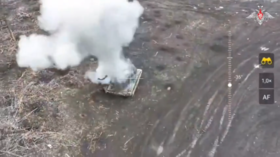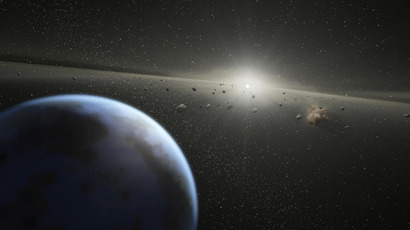Is it a comet? Is it asteroid? ‘Freakish’ six-tail space rock discovered by NASA

A startling and never yet seen “weird and freakish object” with six tails has been captured by NASA's Hubble Space Telescope in our solar system’s asteroid belt between the orbits of Mars and Jupiter.
Scientists were “literally dumbfounded” as they were
trying to find an adequate explanation for out-of-this-world
appearance of this “weird and freakish object,” said the
lead investigator of the University of California at Los Angeles,
David Jewitt, in NASA’s press-release.
While normal asteroids appear as tiny points of light, the
designated P/2013 P5 has six comet-like tails of dust radiating
from it.
“Even more amazing, its tail structures changed dramatically
in just 13 days as it belches out dust. That also caught us by
surprise. It's hard to believe we're looking at an asteroid.”
Asteroids are remnants of disrupted planet formation located in
the belt between Mars and Jupiter. These solid objects that could
have become planets but the process was interrupted by the
gravitational pull of Jupiter. Asteroids differ from comets as
they are found closer to the sun and do not produce a temporary
atmosphere. As for comets, they are characterized as relatively
small, at times active, objects whose ices can vaporize in
sunlight forming a visible atmosphere around it called a ‘coma’
or a ‘tail.’
The research team believes that the asteroid is rotating so much
that its surface is flying apart ejecting dust in episodic
eruptions that form the visible tails and make it look like a
comet.
“If the asteroid's spin rate became fast enough the asteroid's
weak gravity would no longer be able to hold it together. Dust
might avalanche downslope towards the equator, and maybe shatter
and fall off, eventually drifting into space to make a tail,”
Jewitt said.

In the process of spinning the object with a 700-foot radius has lost only a small fraction of its mass, supposedly 100 to 1,000 tons of dust, the researchers said.
“The orbit of the asteroid could make it a member of the Flora asteroid family. This means that it is probably a piece from an asteroid collision that occurred roughly 200 million years ago” said the lead investigator.
The fragments from the collision are following similar orbits, heated to as much as 815.5 Celsius. This indicates that the asteroid is made up of metamorphic rocks, which are not capable of holding ice, suggesting that it is an asteroid and not a comet.
The asteroid started radiating dust five months ago, said the study published in this week’s issue of The Astrophysical Journal Letters.
It was first spotted by Pan-STARRS survey telescope in Hawaii as an unusually fuzzy-looking object, while the multiple tails were discovered by Hubble on September 10. The images taken by Hubble later on September 23 showed a drastically different object dazzling the researchers.
“We were completely knocked out,” Jewitt said, adding that the object looked as if the entire structure had swung around after the previous observation.
Researchers said rotational breakup must be a common phenomenon in the asteroid belt, suggesting that this may be the way that small asteroids die.
“In astronomy, where you find one, you eventually find a whole bunch more,” Jewitt said. “This is just an amazing object to us, and almost certainly the first of many more to come.”














